J’ai comparé les 7 fournisseurs SMTP les plus populaires afin de déterminer les meilleurs choix pour les ingénieurs logiciels et les spécialistes du marketing par email.
Dans la section suivante, je vous présente un aperçu des principaux concurrents, la méthodologie à suivre pour faire un choix éclairé et des analyses approfondies de chaque fournisseur.
C’est parti !
Meilleurs fournisseurs de services SMTP : aperçu
- La Plateforme de Livraison d’Email Mailtrap est idéale pour les entreprises qui envoient des emails à grande échelle et recherchent un SMTP fiable offrant une délivrabilité élevée et les meilleures analyses du secteur.
- SendGrid : pour les grandes entreprises qui recherchent des outils marketing en plus d’un service de livraison d’emails SMTP.
- Mailgun : pour les entreprises qui recherchent un service SMTP simple, mais aussi des API bien documentées.
- Mailchimp Transactional Email : pour les utilisateurs actuels de Mailchimp qui souhaitent étendre les services marketing de Mailchimp aux emails transactionnels (déclenchés par l’utilisateur).
- Amazon SES : idéal pour les utilisateurs avertis qui préfèrent un service économique et un processus de configuration entièrement manuel (nécessitant beaucoup de codage).
- Mailjet : pour les entreprises qui souhaitent faire du marketing par SMS en plus des emails à grande échelle.
- Postmark : pour les entreprises qui souhaitent un service SMTP simple pour envoyer des emails générés par les utilisateurs ou en masse.
Voici un tableau récapitulatif de chaque fournisseur. Cliquez sur les liens pour accéder aux avis individuels.
| Fournisseur SMTP | Formule gratuite | Tarifs |
| Mailtrap | 4 000 emails/mois | À partir de 15 $/mois pour 10 000 emails |
| SendGrid | 100 emails/jour | À partir de 15 $/mois pour 15 000 emails |
| Mailgun | 6 000 emails/mois | À partir de 15 $/mois pour 10 000 emails |
| Mailchimp | 1 000 emails/mois | 12,30 $/mois pour 5 000 emails |
| Amazon SES | 3 000 emails/mois pendant les 12 premiers mois | Paiement à l’utilisation 0,10 $ par 1 000 emails + frais supplémentaires |
| Mailjet | 6 000 emails/mois | À partir de 17 $/mois pour 15 000 emails |
| Postmark | Essai gratuit uniquement | À partir de 15 $/mois pour 10 000 emails |
*Les informations tarifaires sont basées sur les données disponibles en janvier 2025. Pour obtenir les tarifs les plus récents, consultez les sites Web officiels des fournisseurs.
Critères de comparaison des fournisseurs SMTP
Lorsque j’ai comparé les fournisseurs SMTP (Simple Mail Transfer Protocol), j’ai cherché à trouver le meilleur équilibre entre leur infrastructure d’email, leurs tarifs, leur expérience client et l’ensemble des fonctionnalités proposées.
De plus, j’ai vérifié leur plateforme marketing (le cas échéant) et les options de suivi des emails.
Poursuivez votre lecture pour en savoir plus.
Infrastructure d’email
Je vais parler de la délivrabilité, de la fiabilité et de l’évolutivité.
Délivrabilité
Une attention particulière portée à la délivrabilité des emails implique :
- L’authentification des emails via DKIM, SPF et DMARC
- La surveillance des rebonds et des plaintes pour spam
- Des Webhooks pour les notifications d’événements en temps réel
- Des listes de suppression pour la segmentation de base et la gestion des destinataires
- Une adresse IP dédiée pour les expéditeurs à volume élevé
Remarque : pour ce qui précède, je pars du principe que vous êtes un expéditeur de confiance et que votre nom de domaine n’a pas été mis sur liste noire. Si ce n’est pas le cas, vous devrez d’abord rétablir votre réputation afin d’éviter que vos emails ne soient directement envoyés dans le dossier spam.
Cependant, tous les fournisseurs SMTP n’offrent pas les mêmes performances en matière de délivrabilité et de placement dans la boîte de réception. Nous avons mené un test de délivrabilité indépendant afin de comparer les fournisseurs dans des conditions identiques :
- Forfait gratuit
- IP partagées
- Même modèle d’email
- Test des seeds pour la surveillance du placement dans la boîte de réception
Voici les performances de chaque fournisseur SMTP :
| Service SMTP | Résultats de placement des emails |
| Mailtrap | Boîte de réception : 78.8% Onglets : 4.8% Spam : 14.4% Manquant : 2.0% |
| Amazon SES | Boîte de réception : 77.1% Onglets : 1.9% Spam : 20.0% Manquant : 1.0% |
| Mailgun | Boîte de réception : 71.4% Onglets : 3.8% Spam : 23.8% Manquant : 1.0% |
| SendGrid | Boîte de réception : 61.0% Onglets : 1.0% Spam : 17.1% Manquant : 20.9% |
| Postmark | Boîte de réception : 83.3% Onglets : 1.0% Spam : 14.3% Manquant : 0.9% |
Pour connaître les résultats complets et la méthodologie, consultez notre blog Comparaison de la délivrabilité des emails.
Fiabilité
Vous avez besoin d’un fournisseur SMTP qui garantit une disponibilité élevée et des interruptions de service minimales (même avec un serveur SMTP gratuit). Recherchez des fournisseurs qui ont fait leurs preuves en matière d’infrastructure redondante et de mécanismes robustes de reprise après sinistre, notamment :
- Plusieurs serveurs (centres de données ou emplacements de serveurs)
- Des systèmes de stockage pour éviter les points de défaillance uniques et minimiser les temps d’arrêt
- Redondance du réseau (connexions réseau redondantes provenant de différents fournisseurs)
- Des mécanismes d’équilibrage de charge et de basculement (Mailtrap propose ActionMailer balancer que vous pouvez utiliser pour renforcer davantage votre infrastructure d’email en cas de défaillance d’un service d’email SMTP. Découvrez-le sur GitHub.
Évolutivité
Tenez compte du volume d’emails que vous prévoyez d’envoyer et vérifiez si le fournisseur propose des forfaits ou des niveaux de prix flexibles pour s’adapter à votre croissance. Par exemple, la formule Mailtrap Email API/SMTP Basic commence à 10 000 emails par mois pour 10 $. Mais si vous avez besoin de 100 000 emails par mois, vous pouvez facilement passer à une formule supérieure sans payer 10 fois plus cher.
Tarifs
Lorsque je sélectionne des fournisseurs, je privilégie les forfaits transparents et raisonnables. Mon objectif est essentiellement de vous offrir le meilleur équilibre entre une infrastructure d’email fiable et des fonctionnalités performantes, sans compromettre les taux de livraison.
Cependant, je ne connais pas votre budget ni vos besoins en matière de fonctionnalités. C’est pourquoi, lorsque j’évalue les fournisseurs, je vous propose un aperçu détaillé des fonctionnalités et des tarifs actuels.
Notez que tous les fournisseurs n’ont pas la même structure tarifaire. Je vous indiquerai précisément les points auxquels vous devez prêter attention, en particulier si vous envoyez un volume important d’emails ou si vous avez besoin d’outils supplémentaires.
Conformité
La conformité réglementaire n’est pas facultative, en particulier pour les secteurs tels que la FinTech, la santé ou le droit. Lorsque vous évaluez les fournisseurs SMTP, veillez à vérifier en priorité les normes et fonctionnalités clés suivantes :
- Certifications : recherchez les certifications SOC 2 Type II et ISO 27001.
- Prise en charge du RGPD / HIPAA : assurez-vous que les données soient protégées pendant leur transfert et leur stockage.
- Authentification et contrôles d’accès : évaluez la mise en œuvre des protocoles SPF, DKIM, DMARC, des clés temporaires et de la portée des clés API.
- Auditabilité : vérifiez les journaux détaillés des emails, le chiffrement et le suivi des informations au niveau de l’accès.
Pour faciliter l’évaluation, j’ai procédé à une comparaison détaillée des services SMTP présentés dans cet article. En voici un bref résumé :
| Mailtrap | Mailgun | SendGrid | Amazon SES | Postmark | |
| Conformité réglementaire | Élevée | Élevée | Élevée | Dépend de la configuration | Élevée |
| Résidence des données | UE/États-Unis | UE/États-Unis | Monde entier | Plusieurs régions | États-Unis |
| Audit et responsabilité | Excellent | Bon | Très bon | Détaillé | Bon |
| Contrôles d’accès et d’utilisateur | Granulaires | Bons | Très bons | Étendus | Bons |
| Contrôle et conservation des données | Flexible | Flexible | Flexible | Configurable | Flexible |
| Conformité juridique | Solide | Solide | Solide | Solide | Solide |
| Certifications | ISO 27001 | SOC 2 | SOC 2, ISO | Nombreuses (AWS) | SOC 2 |
Si vous souhaitez en savoir plus sur la méthodologie ou comparer les fournisseurs en détail, veuillez consulter notre comparaison de la conformité des fournisseurs SMTP.
Assistance clientèle et expérience utilisateur
Recherchez des fournisseurs qui proposent plusieurs canaux d’assistance, tels que le chat en direct, l’assistance par email ou par téléphone.
Rendez-vous sur les forums, les réseaux sociaux et les sites web répertoriant les logiciels pour vérifier la présence du service que vous avez choisi. Prêtez une attention particulière aux sections consacrées aux avis et aux commentaires, ainsi qu’à la rapidité (le cas échéant) avec laquelle le représentant du service répond aux questions des utilisateurs et aux commentaires négatifs.
Passez ensuite à la documentation des fournisseurs. Cela vous aidera à déterminer la rapidité et la facilité avec lesquelles vous pourrez commencer à utiliser le service SMTP. Les documents vous donneront également un premier aperçu de la complexité du logiciel et de l’expérience utilisateur.
Par exemple, chez Mailtrap, nous fournissons à nos clients les éléments suivants :
- Documents d’aide avec des guides détaillés de configuration et de dépannage.
- Blog avec des guides détaillés comprenant des codes et des modèles utilisables.
- Chaîne YouTube avec des guides visuels et des tutoriels étape par étape.
Envoi d’emails transactionnels
Pour moi, l’un des premiers signes révélateurs d’un bon fournisseur est la possibilité d’envoyer des emails déclenchés par l’utilisateur. C’est encore mieux s’il propose des API et SDK puissants pour différents langages de programmation (Python, PHP, Node.js, etc.).
Cela dit, je vérifie la documentation de l’API pour m’assurer que tout est bien documenté. Je fais également des recherches sur Internet pour voir ce que les autres utilisateurs disent de la délivrabilité et de la facilité d’utilisation du service.
Mais pourquoi devriez-vous vous intéresser aux emails déclenchés par l’utilisateur et aux API ?
Tout d’abord, les API vous permettent d’automatiser une grande partie de l’envoi d’emails depuis votre application ou votre service. Ensuite, les emails déclenchés par l’utilisateur (comme la confirmation d’inscription) font partie des premiers points de contact avec le client. Vous devez donc vous assurer qu’ils fonctionnent parfaitement avec n’importe quel fournisseur de service de messagerie et qu’ils contribuent à mettre en valeur votre marque.
De plus, les fournisseurs devraient proposer des outils qui peuvent vous aider dans ce domaine, en particulier si vous êtes encore en phase de développement. Citons par exemple Mailtrap MCP et Postmark MCP, que vous pouvez connecter à votre IDE pour envoyer vos emails ou simplement fluidifier votre flux de travail.
Bien que ces outils ne soient pas indispensables et soient relativement nouveaux, ils améliorent considérablement la qualité de vie.
Envoi d’emails marketing
Je suis spécialiste en marketing, je recherche donc généralement des options d’automatisation et de segmentation de la clientèle. Ensuite, je vérifie la facilité avec laquelle il est possible de créer des emails (par exemple, interface glisser-déposer). Et dans l’idéal, je voudrais pouvoir télécharger les modèles HTML dont je dispose déjà.
En ce qui concerne la segmentation de la clientèle, je souhaite pouvoir importer ma liste d’emails et disposer d’un moyen simple de mettre en correspondance les destinataires avec les emails et les cohortes de campagne correspondants. De plus, je devrais pouvoir supprimer facilement les clients inactifs, les désabonnements et les rebonds (par exemple, grâce à une option de gestion de liste qui indique qui n’a jamais répondu ou interagi avec mes emails).
Enfin, il serait formidable de disposer de tests A/B pour évaluer plus facilement le type d’emails qui trouve le plus d’écho auprès de chaque groupe de clients.
Avant de passer aux avis, je tiens à souligner que la plupart des fournisseurs ne proposent pas tous les services de marketing par email dans leur offre de base. Mais c’est tout à fait normal et prévisible.
Avertissement : les avis ci-dessous contiennent des évaluations de catalogues de logiciels, des tarifs et des listes de fonctionnalités. Ceux-ci étaient valables au moment de la rédaction, mais pourraient être modifiés au moment où vous lirez cet article.
Meilleur fournisseur SMTP : Plateforme de Livraison d’Email Mailtrap
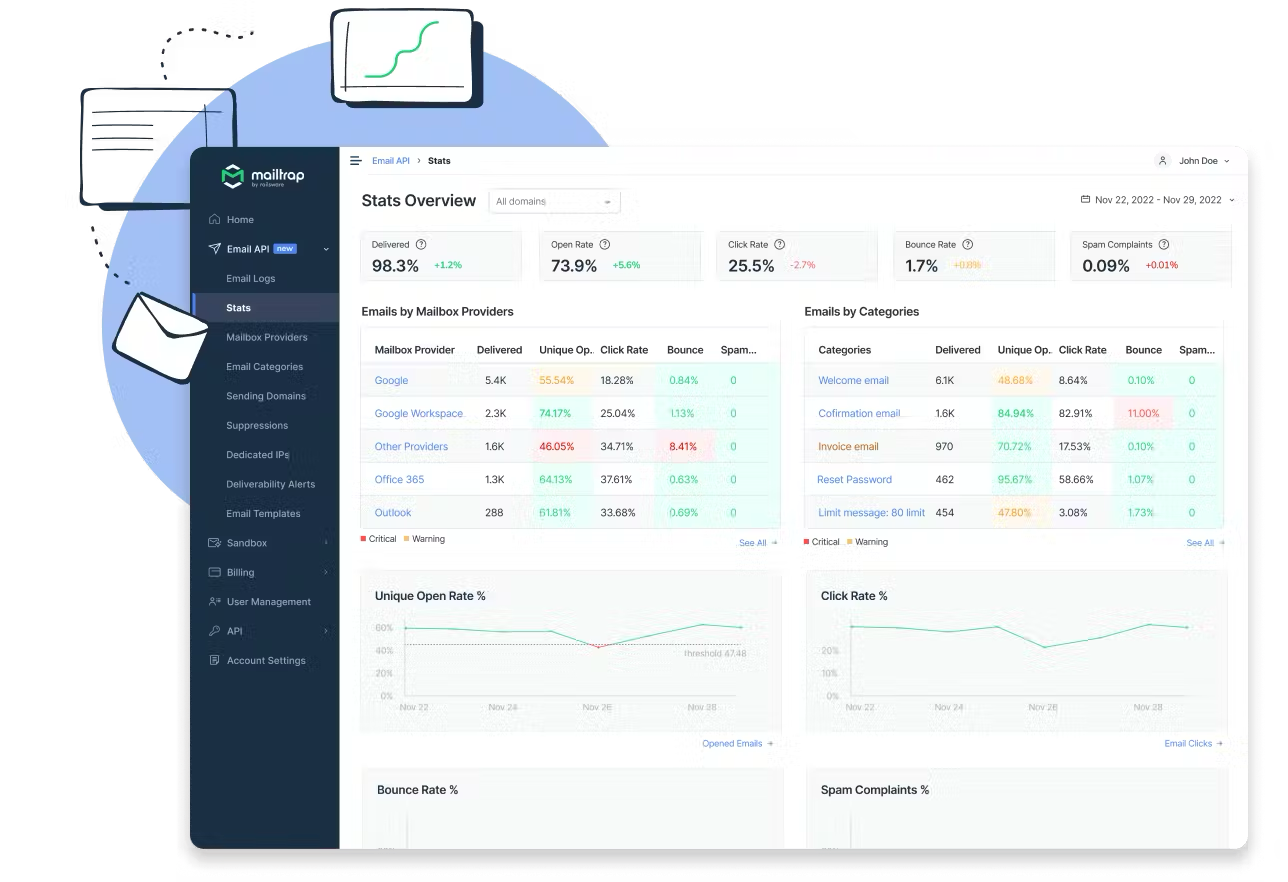
La Plateforme de Livraison d’Email Mailtrap est conçue pour les entreprises qui envoient un volume important d’emails. Elle est idéale pour les équipes de développement à la recherche d’un fournisseur SMTP fiable qui met l’accent sur la délivrabilité des emails et offre une expérience de développement de premier ordre.
Mailtrap fournit plus de 25 extraits de code prêts à l’emploi pour une intégration rapide et facile à votre application.
Et pour vous montrer à quel point la délivrabilité est importante pour nous, j’ai effectué un test avec GlockApps, qui a montré que 93,2 % des emails envoyés via notre SMTP arrivaient dans la boîte de réception ou dans les onglets (seuls 5,8 % allaient dans les onglets).
Il n’est donc pas surprenant que StackOverflow, PayPal, Atlassian et Adobe comptent parmi les clients de Mailtrap.
Tarifs
L’offre gratuite permet aux utilisateurs d’envoyer jusqu’à 4 000 emails par mois. Cette offre gratuite est très généreuse, d’autant plus qu’elle inclut des webhooks, des analyses d’emails, la gestion des suppressions, et bien plus encore.
Pour les entreprises qui envoient un grand nombre d’emails, je recommande notre forfait Business, le plus populaire. À partir de 85 $ par mois, il comprend jusqu’à 100 000 contacts par mois, l’assistance d’une équipe dédiée à la délivrabilité, une adresse IP dédiée et bien plus encore. Consultez notre page Tarifs pour plus de détails.
Avantages et inconvénients
Avantages
- Mailtrap fournit une infrastructure sécurisée (TLS/SSL) et fiable pour les emails de production.
- Une équipe veille à ce que nos systèmes et nos adresses IP soient exempts de spammeurs sans vous obliger à remplir de longs formulaires de vérification.
- Des instructions de configuration claires sont fournies pour de nombreux types de projets différents, avec un assistant de configuration intuitif, ce qui facilite l’intégration dans votre application.
- Vous bénéficiez d’analyses approfondies exploitables grâce à un tableau de bord offrant une vue d’ensemble, des rapports détaillés et des journaux d’emails pour contrôler les performances de votre infrastructure d’email.
- Mailtrap respecte la conformité au RGPD et sa certification ISO 27001 pour tous les plans API/SMTP d’email.
- Une assistance humaine est disponible 24 heures sur 24 et 7 jours sur 7 pour répondre à toutes vos questions, avec des experts en délivrabilité à votre disposition.
- Flux séparés pour les emails transactionnels et les emails en masse.
- Il offre une intégration aux serveurs MCP via Claude, Cursor ou l’éditeur de code VSC.
Inconvénients
- Actuellement, vous ne pouvez intégrer Mailtrap qu’à des services tels que Zapier et Tabular email, mais d’autres intégrations sont en cours de développement.
SendGrid
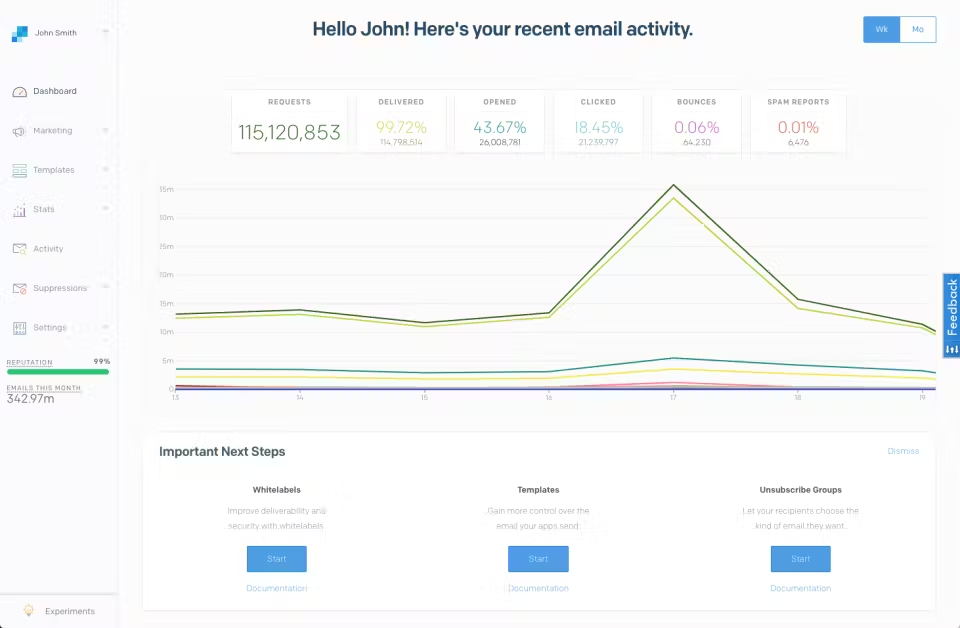
SendGrid est principalement destiné aux développeurs et aux spécialistes du marketing qui ont besoin d’un service d’email évolutif s’intégrant facilement à diverses applications. Il convient aux entreprises qui gèrent à grande échelle des emails générés par les utilisateurs et des emails marketing via une seule plateforme.
Cependant, vous devez savoir que certains utilisateurs soulignent la complexité de la configuration et la lenteur des services d’assistance lors du choix de leur forfait. De plus, si vous avez besoin d’une authentification à deux facteurs (2FA), vous ne pouvez le faire qu’avec Authy ou par SMS, ce qui n’est pas vraiment la méthode d’authentification appropriée pour une infrastructure d’email, car elle est liée à un numéro de téléphone.
Tarifs
SendGrid propose une structure tarifaire à plusieurs niveaux, segmentée en forfaits pour les développeurs et les spécialistes du marketing, qui comprennent tous deux un forfait gratuit.
- Pour les développeurs, le forfait Essentials est disponible à partir de 19,95 $ par mois.
- Pour les spécialistes du marketing, le forfait Basic est proposé à partir de 15 $ par mois.
À première vue, la tarification semble assez simple. Mais sachez que la structure réelle est assez complexe et qu’il existe de nombreuses options supplémentaires et compléments qui peuvent rapidement faire grimper le coût réel.
Par exemple, le forfait Essentials pour les développeurs offre 100 000 emails par mois. Mais vous ne pouvez avoir qu’un seul membre dans votre équipe, il n’y a pas d’adresse IP dédiée ni d’authentification unique (SSO). Pour bénéficier de ces fonctionnalités, vous devez choisir un forfait supérieur à 89,95 $ par mois.
Avantages
- API complètes : API robustes pour les activités liées aux emails, y compris des analyses détaillées pour l’optimisation des campagnes.
- Évolutivité : gère de grands volumes.
- Intégration : intégration possible avec diverses plateformes et applications.
Inconvénients
- Configuration complexe : le processus initial de configuration et d’intégration est complexe, en particulier lorsqu’il s’agit de fonctionnalités avancées.
- Assistance clientèle : l’assistance peut être lente, en particulier pour les forfaits les moins chers.
- Automatisation du marketing : disponible uniquement avec la formule Advanced marketing.
Si vous recherchez d’autres alternatives à SendGrid, consultez l’article lié.
Mailgun
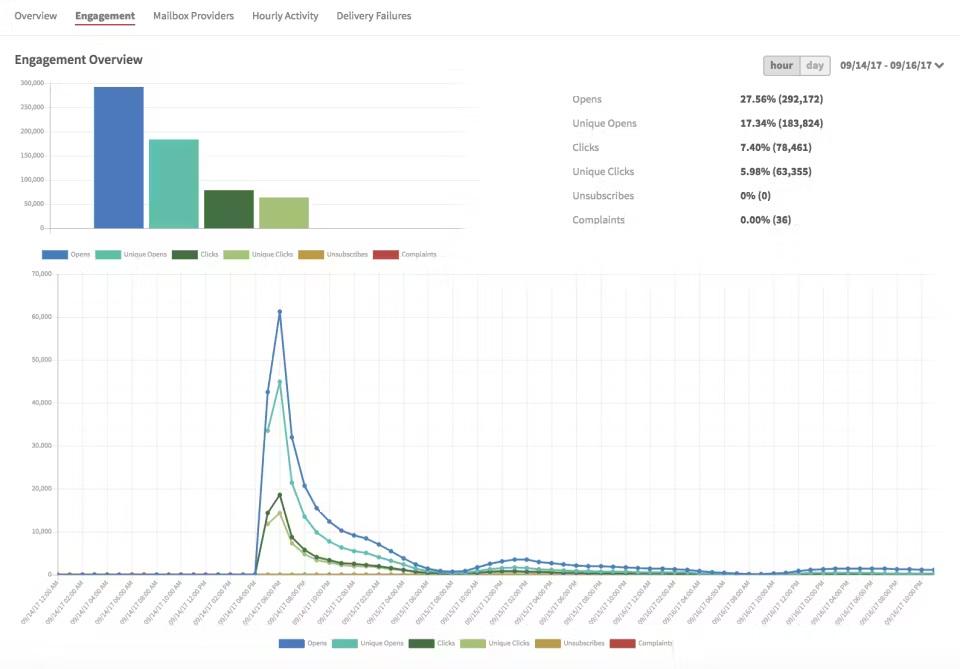
Mailgun est conçu pour les développeurs qui ont besoin d’un service SMTP programmable pour les emails déclenchés par les utilisateurs. Et, depuis peu, Mailgun propose également un service marketing.
En général, ce fournisseur SMTP est plébiscité par les utilisateurs avertis qui souhaitent gérer un volume important d’emails avec un contrôle précis et des informations détaillées. Il convient principalement aux petites entreprises.
Cependant, vous devez vous préparer à une expérience d’authentification quelque peu maladroite via les enregistrements DNS. Vous devez également tenir compte du coût total de possession pour les volumes élevés.
Tarifs
Mailgun propose une formule gratuite et plusieurs formules à plusieurs niveaux offrant davantage de fonctionnalités et des limites d’envoi plus élevées. La formule Basic est disponible à partir de 15 $ par mois, mais prêtez une attention particulière aux limitations, surtout si vous travaillez en équipe.
Avantages
- API flexible : l’API de Mailgun est conviviale pour les développeurs et prend en charge les intégrations et les automatisations personnalisées.
- Forte délivrabilité : comprend des outils sophistiqués de validation des emails pour améliorer les taux de placement dans la boîte de réception.
- Évolutivité : s’adapte efficacement à l’augmentation des besoins en matière d’emails sans perte de performances.
Inconvénients
- Courbe d’apprentissage : les fonctionnalités robustes de la plateforme peuvent être complexes, ce qui nécessite une courbe d’apprentissage plus raide pour les nouveaux utilisateurs.
- Tarification pour les volumes élevés : les coûts peuvent augmenter rapidement avec des niveaux de volume plus élevés, ce qui peut ne pas être rentable pour toutes les entreprises.
- Enregistrements DNS : aucune option permettant de partager le DNS avec d’autres personnes.
Pour plus d’informations, consultez l’article sur les alternatives à Mailgun. Nous proposons également une comparaison complète entre Mailgun et SendGrid. Cliquez sur le lien pour accéder à l’article.
Mailchimp Transactional Email
G2: 4.2 Capterra: N/A
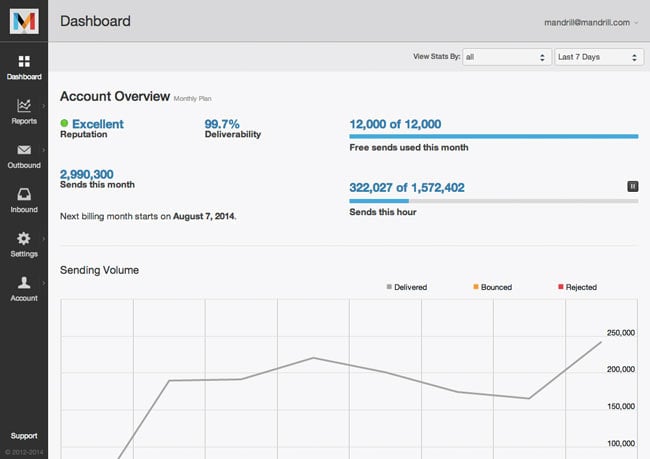
Anciennement connu sous le nom de Mandrill, Mailchimp Transactional Email s’adresse à ceux qui utilisent déjà Mailchimp pour leurs emails marketing et qui souhaitent disposer d’un ensemble d’outils cohérent alliant marketing et communications déclenchées par les utilisateurs.
Cependant, le coût et la complexité de la plateforme peuvent être des facteurs à prendre en compte pour les entreprises qui n’ont pas encore investi dans l’écosystème Mailchimp.
Tarifs
Mailchimp Transactional Email est un add-on (module complémentaire) au compte Mailchimp principal et nécessite que les utilisateurs souscrivent à un abonnement Mailchimp payant. La tarification est basée sur le volume d’emails envoyés, avec des blocs d’emails disponibles à l’achat. Le coût par bloc d’emails diminue à mesure que le volume augmente.
Je ne dirais pas que la tarification n’est pas transparente, mais le système de blocs est déroutant.
Je vous recommande donc d’utiliser leur calculateur pour estimer le prix. Par exemple, si vous souhaitez envoyer 100 000 emails déclenchés par les utilisateurs, Mailchimp les divise en 4 blocs de 20 $ chacun, ce qui signifie que vous payez 80 $ par mois.
Avantages
- Intégrations : Mailchimp permet des intégrations avec plusieurs plateformes, notamment Salesforce, Shopify, Wix et, fait intéressant, Canva.
- Interface conviviale : un éditeur simple par glisser-déposer et de nombreux modèles prédéfinis.
- Fonctionnalités : comprend des tests A/B, l’envoi différé et des analyses détaillées, mais attention aux limitations liées à votre forfait.
- Fiabilité : conformité intégrée et surveillance de la réputation.
Inconvénients
- Coût : peut être coûteux pour ceux qui ont besoin d’envoyer un grand nombre d’emails, car il nécessite un forfait Mailchimp et des frais supplémentaires pour les emails transactionnels.
- Complexité pour les non-spécialistes du marketing : bien qu’il s’intègre bien à Mailchimp, les utilisateurs qui ne sont pas familiarisés avec la plateforme Mailchimp peuvent le trouver moins intuitif.
- Limites de l’assistance : l’assistance peut être lente ou moins utile que prévu, en particulier pour les problèmes techniques.
Si vous souhaitez savoir comment Mailchimp Transactional se positionne par rapport à ses concurrents, consultez l’article lié. Nous proposons également deux autres tutoriels qui vous aideront à prendre une décision plus éclairée :
- Sendgrid vs Mandrill vs Mailgun – Comment choisir ?
- Sendgrid vs Mailchimp : conception, délivrabilité, marketing
Amazon SES
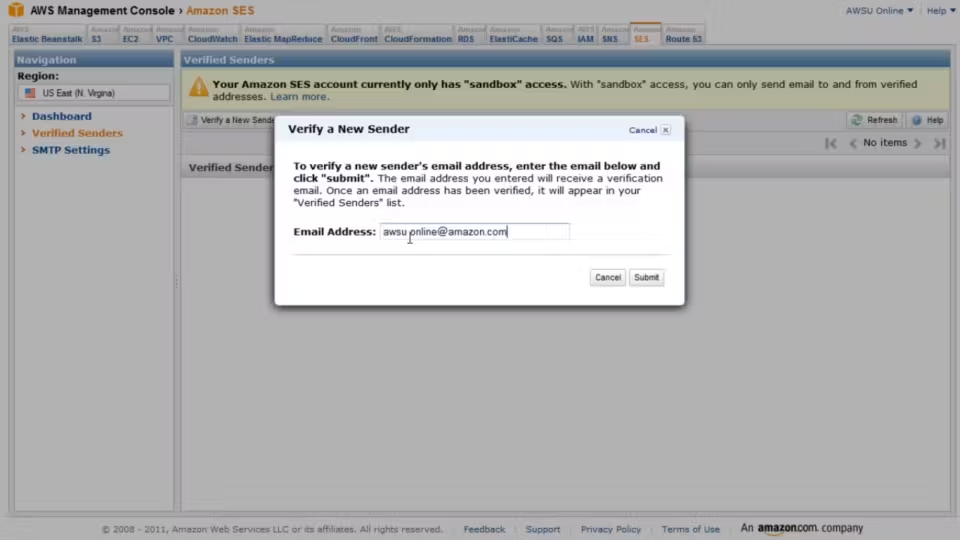
Amazon Simple Email Service (SES) est conçu pour les développeurs qui recherchent une solution d’envoi et de réception d’emails hautement évolutive et rentable. Il convient particulièrement à ceux qui sont déjà intégrés dans l’écosystème AWS, par exemple les utilisateurs de S3 et Lambda.
Il est important de souligner que SES est uniquement destiné aux entreprises technophiles disposant d’équipes dédiées à l’infrastructure d’email et recherchant une solution d’email abordable et évolutive dans le cadre des services cloud AWS. Il convient également de noter que des services d’assistance AWS supplémentaires peuvent être nécessaires.
Tarifs
Amazon SES utilise un modèle de tarification à l’utilisation qui facture en fonction du nombre d’emails envoyés et reçus, ainsi que des données transférées.
Par exemple, au niveau le plus bas, vous payez 0,10 $ pour 1 000 emails sortants, et il en va de même pour les emails entrants. Cependant, leur tarification est assez structurée et complexe, vous pouvez donc consulter la page officielle pour déterminer si elle vous convient.
Avantages
- Rentabilité : prix compétitifs, particulièrement avantageux pour les expéditeurs de gros volumes.
- Grande évolutivité : gère facilement les pics importants de volume d’emails sans dégradation du service, grâce à l’infrastructure AWS.
- Déploiement flexible : offre des options pour envoyer des emails directement depuis une application ou en utilisant l’API SES, l’interface SMTP ou le SDK AWS.
- Intégration avec AWS : l’intégration complète avec d’autres services AWS améliore les fonctionnalités pour les utilisateurs déjà présents dans l’écosystème AWS.
Inconvénients
- Configuration complexe : configuration et intégration complexes, en particulier pour les utilisateurs qui ne sont pas familiarisés avec les services AWS.
- Fonctionnalités limitées : bien que puissant, il manque certaines des fonctionnalités plus conviviales que l’on trouve chez d’autres fournisseurs de services d’email, telles que des outils marketing intégrés ou des éditeurs d’emails visuels.
- Assistance clientèle : comme pour de nombreux services AWS, l’assistance peut être coûteuse ; le niveau d’assistance de base peut ne pas répondre aux besoins de tous les utilisateurs, et les niveaux d’assistance supérieurs sont proposés à un prix élevé.
Si vous êtes intéressé par les alternatives à Amazon SES, consultez l’article auquel je renvoie.
Mailjet

Mailjet est principalement conçu pour les campagnes d’email marketing avec un fournisseur de serveur SMTP simple qui vous offre la possibilité d’envoyer des emails déclenchés par l’utilisateur. Il est particulièrement intéressant pour les équipes qui ont besoin d’outils collaboratifs pour concevoir, envoyer et suivre leurs emails.
Par exemple, si vous avez besoin d’un service de relais SMTP pour un site web WordPress ou un site d’e-commerce, Mailjet pourrait être un bon choix. Cependant, vous devez tenir compte des implications financières liées à l’évolutivité et au degré de personnalisation nécessaire.
Tarifs
Mailjet propose une structure tarifaire flexible à plusieurs niveaux, dont un niveau gratuit. Notez que le forfait gratuit inclut la marque Mailjet, il peut donc être utile uniquement à des fins de test. Le forfait payant Essential est disponible à partir de 17 $ par mois.
Avantages
- Interface conviviale : dispose d’un éditeur d’emails intuitif de type glisser-déposer et d’un ensemble d’outils collaboratifs, ce qui facilite le travail en équipe sur les campagnes d’emails.
- Double fonctionnalité : prend en charge efficacement les emails générés par les utilisateurs et les emails marketing.
- Conformité aux normes européennes en matière de données : respect strict des normes européennes de protection des données, ce qui le rend idéal pour les entreprises soucieuses de se conformer au RGPD.
Inconvénients
- Personnalisation limitée : bien que l’interface soit conviviale, vous trouverez peut-être les options de personnalisation des modèles quelque peu restrictives.
- Tarification pour les expéditeurs à volume élevé : à mesure que le volume d’emails augmente, le coût peut augmenter considérablement, ce qui peut ne pas être optimal pour les grandes entreprises.
Devinez quoi, nous avons également publié un article sur les alternatives à Mailjet (10 en tout). N’hésitez pas à les consulter.
Postmark
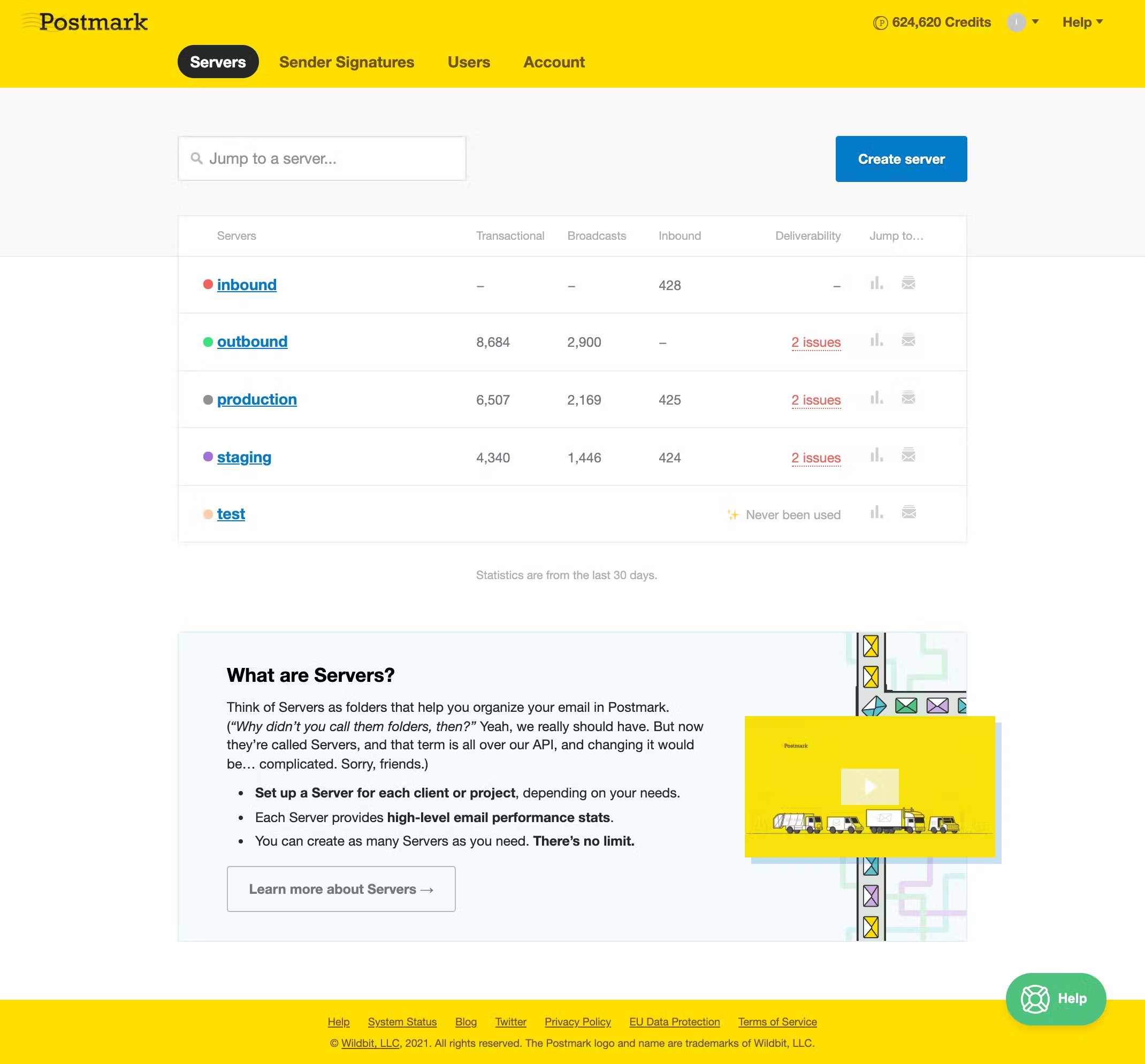
Postmark s’adresse aux spécialistes du marketing et aux développeurs qui ont besoin d’envoyer des emails en masse et déclenchés par les utilisateurs sans compromettre la fiabilité.
Si vous disposez d’une application de niveau entreprise ou d’un site WordPress et que vous accordez la priorité à la livraison immédiate des emails (par exemple, confirmations de commande, réinitialisations de mot de passe et notifications), Postmark est un bon choix.
Toutefois, ceux qui ont besoin d’outils marketing plus complets ou qui fonctionnent avec un budget serré et des volumes élevés devront peut-être envisager des solutions ou des fournisseurs supplémentaires.
Tarifs
Postmark propose une tarification simple, sans frais cachés. Il existe une formule gratuite pour 100 emails par mois et les prix varient en fonction du nombre d’emails que vous envoyez. Par exemple, l’envoi de 100 000 emails par mois coûte 115 $.
Avantages
- Haute délivrabilité : accent mis sur les taux de délivrabilité, avec une gestion proactive de la réputation d’envoi.
- Suivi détaillé : informations détaillées et capacités de suivi, permettant aux utilisateurs de surveiller les ouvertures, les clics et les statuts de livraison.
- Assistance exceptionnelle : assistance clientèle de haute qualité, offrant une aide détaillée et rapide en cas de besoin.
Inconvénients
- Coût à grande échelle : bien que le service soit de haute qualité, son coût peut devenir important à mesure que le volume d’emails augmente, ce qui le rend potentiellement moins adapté aux entreprises soucieuses de leur budget.
- Ensemble de fonctionnalités : bien qu’efficace, l’ensemble de fonctionnalités est plus basique que celui de certains concurrents qui proposent des outils de marketing et d’automatisation plus complets.
En résumé
Dans le domaine des fournisseurs SMTP, Mailtrap se concentre sur des taux de délivrabilité élevés, des analyses approfondies et une évolutivité sûre et rapide, ce qui en fait un choix idéal pour les développeurs. De plus, il offre des limites généreuses pour les emails gratuits (jusqu’à 4 000 emails envoyés par mois).
Oui, je me vante un peu, mais ce ne sont pas que des promesses en l’air. Une équipe d’experts travaille chaque jour pour que vos emails arrivent dans les boîtes de réception sans les tracas habituels. Alors, profitez de notre offre gratuite et voyez si nous répondons à vos attentes.
Avant de conclure, nous tenons à rappeler que certains bons fournisseurs n’ont pas été retenus ici, notamment Brevo (anciennement Sendinblue) et Pepipost by Netcore.
Et si vous travaillez dans un secteur réglementé comme la fintech et que vous avez besoin d’une infrastructure SMTP sécurisée et conforme, consultez notre guide des fournisseurs SMTP pour la FinTech.
Pour savoir quels fournisseurs SMTP domineront en 2025, ne manquez pas notre vidéo dédiée :





